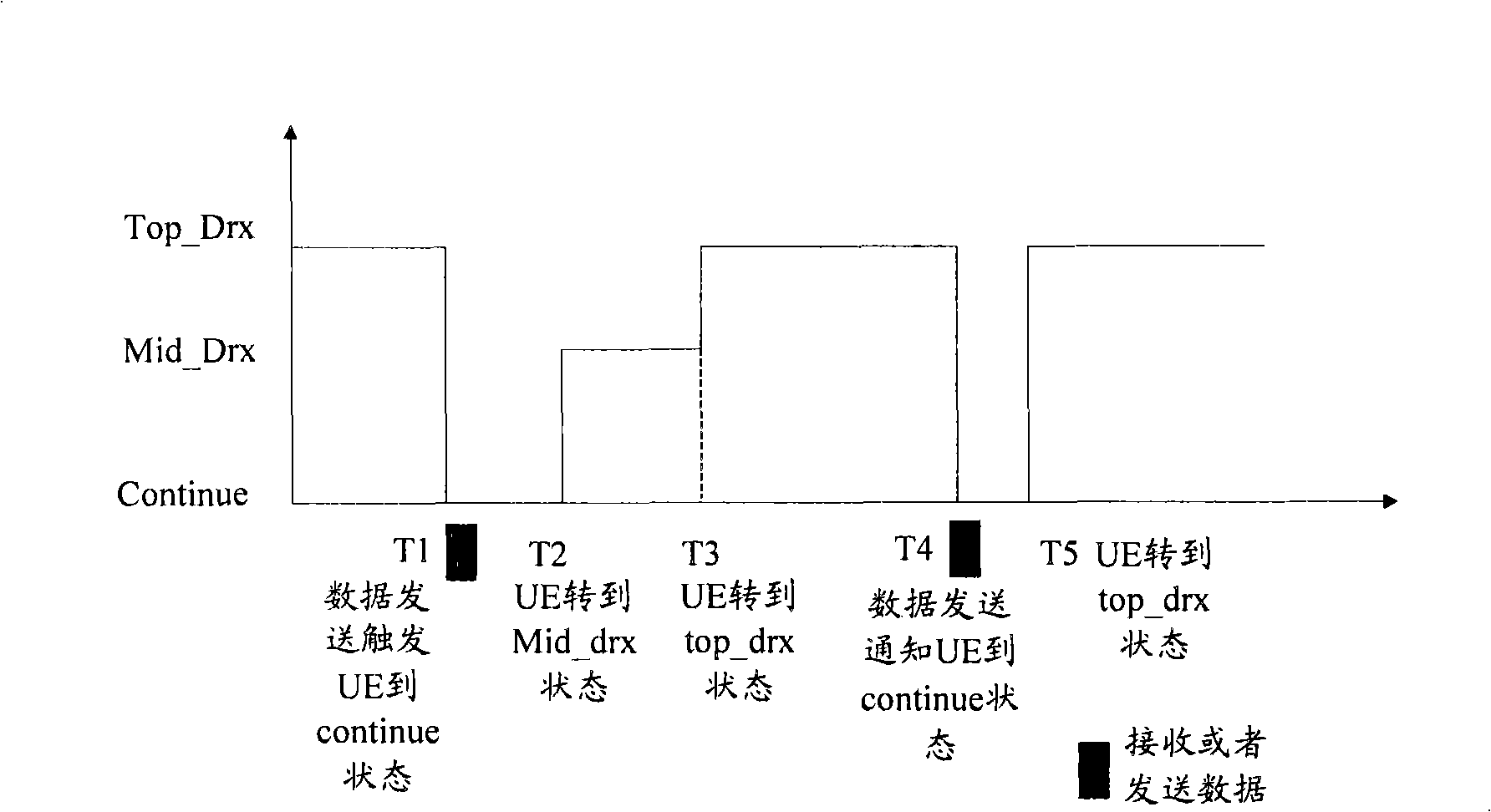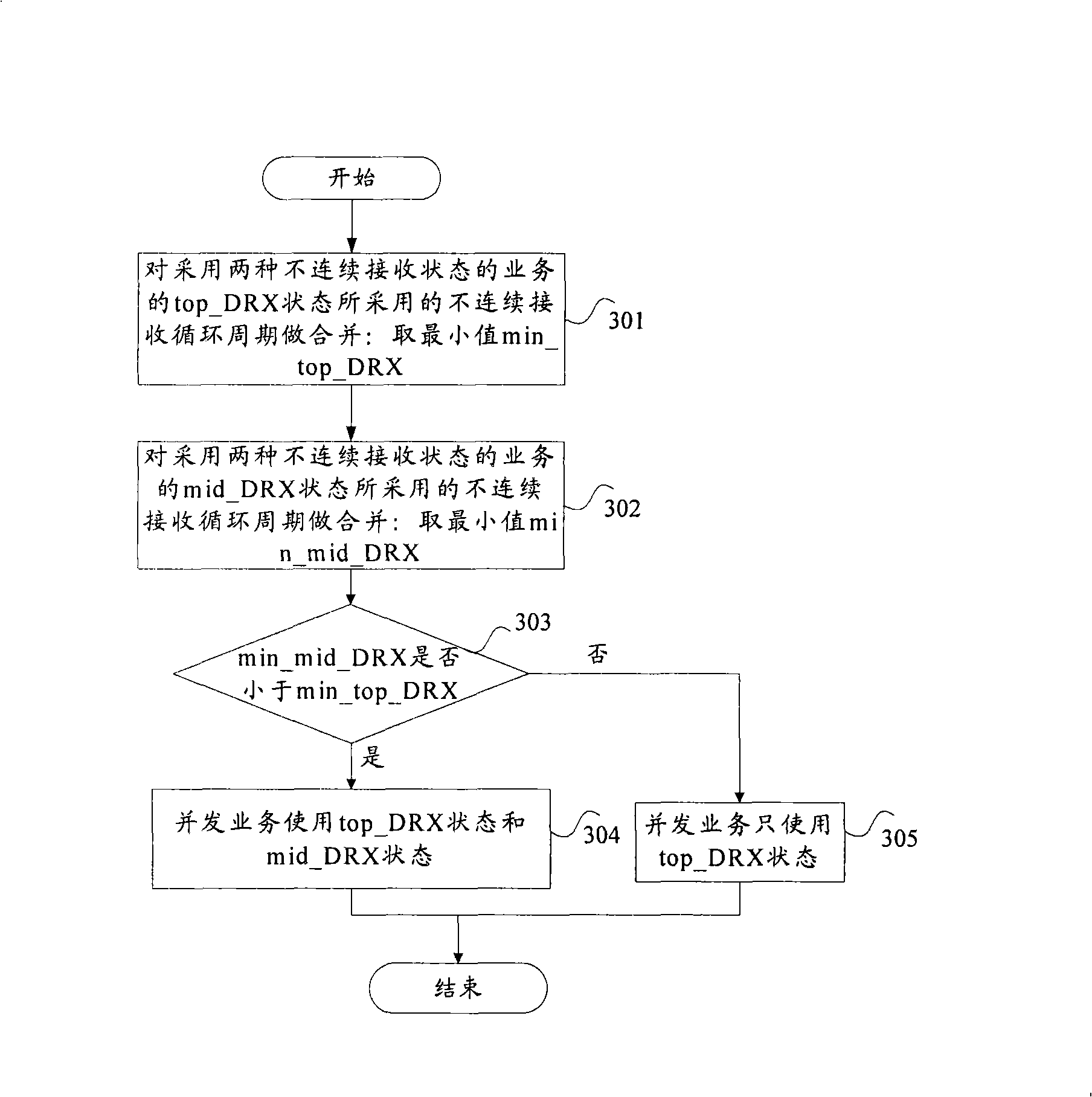Service implementing method using incontinuous accepting state
A technology of receiving state and implementation method, applied in the field of communication, can solve the problems of large delay of voice data, inability to effectively guarantee the service quality of various services, without specific consideration of the specific business requirements of real-time business concurrent services, etc. The effect of improving business processing efficiency
- Summary
- Abstract
- Description
- Claims
- Application Information
AI Technical Summary
Problems solved by technology
Method used
Image
Examples
example 1
[0040] In this example, the method of using the discontinuous reception state for the VOIP service is specifically described, such as figure 1 Shown:
[0041] Time point T1: UE is in the top_DRX state, and when there is data sent to the UE, the UE enters the continue state;
[0042] Time point T2: when the timer for transferring to top_DRX arrives, the UE transfers to the top_DRX state;
[0043] Time point T3: UE is in top_DRX state, when there is data to send to UE, UE turns to continue state;
[0044] Time point T4: the base station notifies the user equipment to enter the top_DRX state through explicit signaling;
[0045] Time point T5: the UE is in the top_DRX state, and when there is data to be sent to the UE, the UE enters the continue state.
[0046] It can be seen from the above processing that in the technical solution provided by the present invention, real-time services such as VOIP services only use the top_DRX state instead of the mid_DRX state.
example 2
[0048] In this example, the method of using the discontinuous reception state for non-real-time services is specifically described, such as figure 2 Shown:
[0049] Time point T1: UE is in the top_DRX state, and when there is data sent to the UE, the UE enters the continue state;
[0050] Time point T2: when the timer for transitioning to mid_DRX arrives, the UE transitions to the mid_DRX state;
[0051] Time point T3: when the timer for transferring to top_DRX arrives, the UE transfers to the top_DRX state;
[0052] Time point T4: UE is in the top_DRX state, and when there is data sent to the UE, the UE enters the continue state;
[0053] Time point T5: the base station notifies the UE to enter the top_DRX state through explicit signaling.
[0054] It can be seen from the above processing that in the technical solution provided by the present invention, non-real-time services can use the top_DRX state and mid_DRX state.
[0055] It should be noted that there may be multi...
example 3
[0066] image 3 shows a specific processing example in this case, such as image 3 shown, including the following steps:
[0067] Step S301, merging the discontinuous reception cycle period adopted by the top_DRX state of the service (ie, non-real-time service) using two discontinuous reception states: take the minimum value min_top_DRX;
[0068] Step S302, merging the discontinuous reception cycles adopted by the mid_DRX state of the services (that is, non-real-time services) using two discontinuous reception states: taking the minimum value min_mid_DRX;
[0069] Step S303, if min_mid_DRX is less than min_top_DRX, execute S304; otherwise execute S305;
[0070] Step S304, the concurrent service uses top_DRX state and mid_DRX state;
[0071] In step S305, the concurrent service only uses the top_DRX state.
[0072] Case 3: Concurrent services are a combination of real-time services and non-real-time services
[0073] In this case, for concurrent services, the method furthe...
PUM
 Login to View More
Login to View More Abstract
Description
Claims
Application Information
 Login to View More
Login to View More - Generate Ideas
- Intellectual Property
- Life Sciences
- Materials
- Tech Scout
- Unparalleled Data Quality
- Higher Quality Content
- 60% Fewer Hallucinations
Browse by: Latest US Patents, China's latest patents, Technical Efficacy Thesaurus, Application Domain, Technology Topic, Popular Technical Reports.
© 2025 PatSnap. All rights reserved.Legal|Privacy policy|Modern Slavery Act Transparency Statement|Sitemap|About US| Contact US: help@patsnap.com



